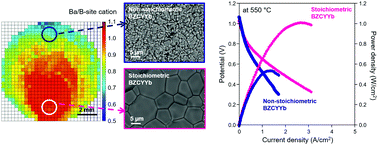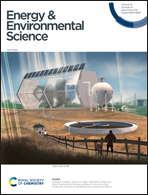Exceptionally high performance of protonic ceramic fuel cells with stoichiometric electrolytes†
Abstract
Proton conducting electrochemical cells, especially protonic ceramic fuel cells (PCFCs), are expected to be a breakthrough technology in next-generation energy conversion systems, primarily because of their high proton conductivity and low activation energy below 600 °C. However, the low chemical and physical stability of proton conducting oxides during the sintering process has resulted in a substantially lower electrochemical performance than their predictions, limiting their utilization and application. Here, we present the fabrication of a stoichiometric BaZr0.4Ce0.4Y0.1Yb0.1O3−δ (BZCYYb) electrolyte with an average grain size of ∼10 μm by controlling the chemical potential of the A-site cation, Ba, near the BZCYYb electrolyte surface during the sintering process. A stoichiometric BZCYYb-based PCFC in an anode-supported configuration exhibits 1.90 W cm−2 and 1.01 W cm−2 with an extremely low ohmic resistance of 0.060 ohm cm2 at 650 °C and 0.082 ohm cm2 at 550 °C, respectively, surpassing the values of all previously reported PCFCs without complicated engineering in materials and structures of other cell components.



 Please wait while we load your content...
Please wait while we load your content...